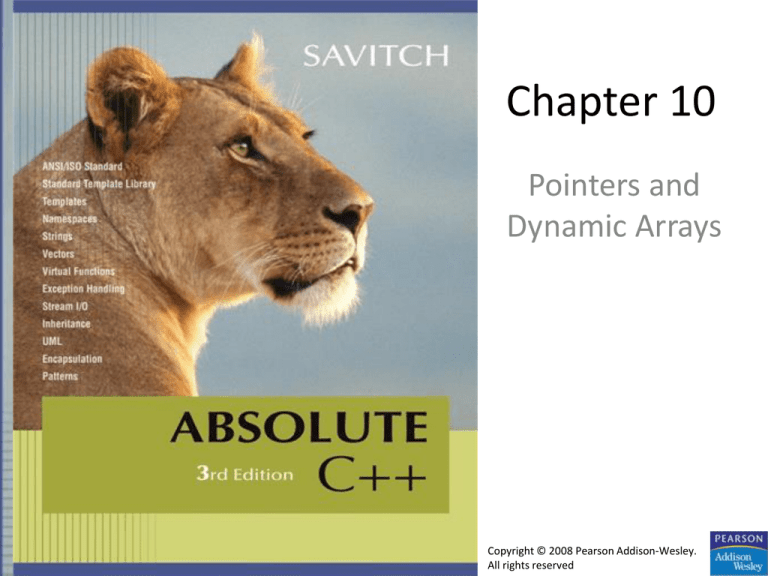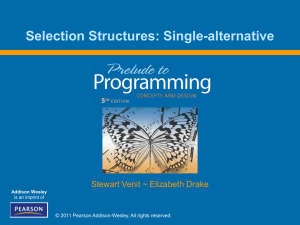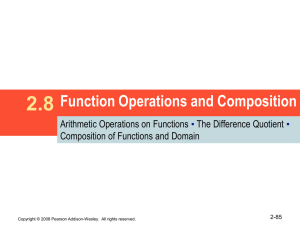
Chapter 10
Pointers and
Dynamic Arrays
Copyright © 2008 Pearson Addison-Wesley.
All rights reserved
Learning Objectives
• Pointers
– Pointer variables
– Memory management
• Dynamic Arrays
– Creating and using
– Pointer arithmetic
• Classes, Pointers, Dynamic Arrays
– The this pointer
– Destructors, copy constructors
Copyright © 2008 Pearson Addison-Wesley. All rights reserved.
10-2
Pointer Introduction
• Pointer definition:
– Memory address of a variable
• Recall: memory divided
– Numbered memory locations
– Addresses used as name for variable
• You’ve used pointers already!
– Call-by-reference parameters
• Address of actual argument was passed
Copyright © 2008 Pearson Addison-Wesley. All rights reserved.
10-3
Pointer Variables
• Pointers are "typed"
– Can store pointer in variable
– Not int, double, etc.
• Instead: A POINTER to int, double, etc.!
• Example:
double *p;
– p is declared a "pointer to double" variable
– Can hold pointers to variables of type double
• Not other types!
Copyright © 2008 Pearson Addison-Wesley. All rights reserved.
10-4
Declaring Pointer Variables
• Pointers declared like other types
– Add "*" before variable name
– Produces "pointer to" that type
• "*" must be before each variable
• int *p1, *p2, v1, v2;
– p1, p2 hold pointers to int variables
– v1, v2 are ordinary int variables
Copyright © 2008 Pearson Addison-Wesley. All rights reserved.
10-5
Addresses and Numbers
• Pointer is an address
• Address is an integer
• Pointer is NOT an integer!
– Not crazy abstraction!
• C++ forces pointers be used as
addresses
– Cannot be used as numbers
– Even though it "is a" number
Copyright © 2008 Pearson Addison-Wesley. All rights reserved.
10-6
Pointing
• Terminology, view
– Talk of "pointing", not "addresses"
– Pointer variable "points to" ordinary variable
– Leave "address" talk out
• Makes visualization clearer
– "See" memory references
• Arrows
Copyright © 2008 Pearson Addison-Wesley. All rights reserved.
10-7
Pointing to …
• int *p1, *p2, v1, v2;
p1 = &v1;
– Sets pointer variable p1 to "point to" int
variable v1
• Operator, &
– Determines "address of" variable
• Read like:
– "p1 equals address of v1"
– Or "p1 points to v1"
Copyright © 2008 Pearson Addison-Wesley. All rights reserved.
10-8
Pointing to …
• Recall:
int *p1, *p2, v1, v2;
p1 = &v1;
• Two ways to refer to v1 now:
– Variable v1 itself:
cout << v1;
– Via pointer p1:
cout *p1;
• Dereference operator, *
– Pointer variable "derereferenced"
– Means: "Get data that p1 points to"
Copyright © 2008 Pearson Addison-Wesley. All rights reserved.
10-9
"Pointing to" Example
• Consider:
v1 = 0;
p1 = &v1;
*p1 = 42;
cout << v1 << endl;
cout << *p1 << endl;
• Produces output:
42
42
• p1 and v1 refer to same variable
Copyright © 2008 Pearson Addison-Wesley. All rights reserved.
10-10
& Operator
• The "address of" operator
• Also used to specify call-by-reference
parameter
– No coincidence!
– Recall: call-by-reference parameters pass
"address of" the actual argument
• Operator’s two uses are closely related
Copyright © 2008 Pearson Addison-Wesley. All rights reserved.
10-11
Pointer Assignments
• Pointer variables can be "assigned":
int *p1, *p2;
p2 = p1;
– Assigns one pointer to another
– "Make p2 point to where p1 points"
• Do not confuse with:
*p1 = *p2;
– Assigns "value pointed to" by p1, to "value
pointed to" by p2
Copyright © 2008 Pearson Addison-Wesley. All rights reserved.
10-12
Pointer Assignments Graphic:
Display 10.1 Uses of the Assignment Operator with
Pointer Variables
Copyright © 2008 Pearson Addison-Wesley. All rights reserved.
10-13
The new Operator
• Since pointers can refer to variables…
– No "real" need to have a standard identifier
• Can dynamically allocate variables
– Operator new creates variables
• No identifiers to refer to them
• Just a pointer!
• p1 = new int;
– Creates new "nameless" variable, and
assigns p1 to "point to" it
– Can access with *p1
• Use just like ordinary variable
Copyright © 2008 Pearson Addison-Wesley. All rights reserved.
10-14
Basic Pointer Manipulations Example:
Display 10.2 Basic Pointer
Manipulations (1 of 2)
Copyright © 2008 Pearson Addison-Wesley. All rights reserved.
10-15
Basic Pointer Manipulations Example:
Display 10.2 Basic Pointer
Manipulations (2 of 2)
Copyright © 2008 Pearson Addison-Wesley. All rights reserved.
10-16
Basic Pointer
Manipulations
Graphic:
Display 10.3
Explanation of
Display 10.2
Copyright © 2008 Pearson Addison-Wesley. All rights reserved.
10-17
More on new Operator
• Creates new dynamic variable
• Returns pointer to the new variable
• If type is class type:
– Constructor is called for new object
– Can invoke different constructor with
initializer arguments:
MyClass *mcPtr;
mcPtr = new MyClass(32.0, 17);
• Can still initialize non-class types:
int *n;
n = new int(17);
//Initializes *n to 17
Copyright © 2008 Pearson Addison-Wesley. All rights reserved.
10-18
Pointers and Functions
• Pointers are full-fledged types
– Can be used just like other types
• Can be function parameters
• Can be returned from functions
• Example:
int* findOtherPointer(int* p);
– This function declaration:
• Has "pointer to an int" parameter
• Returns "pointer to an int" variable
Copyright © 2008 Pearson Addison-Wesley. All rights reserved.
10-19
Memory Management
• Heap
– Also called "freestore"
– Reserved for dynamically-allocated variables
– All new dynamic variables consume memory
in freestore
• If too many could use all freestore memory
• Future "new" operations will fail if freestore
is "full"
Copyright © 2008 Pearson Addison-Wesley. All rights reserved.
10-20
Checking new Success
• Older compilers:
– Test if null returned by call to new:
int *p;
p = new int;
if (p == NULL)
{
cout << "Error: Insufficient memory.\n";
exit(1);
}
– If new succeeded, program continues
Copyright © 2008 Pearson Addison-Wesley. All rights reserved.
10-21
new Success – New Compiler
• Newer compilers:
– If new operation fails:
• Program terminates automatically
• Produces error message
• Still good practice to use NULL check
Copyright © 2008 Pearson Addison-Wesley. All rights reserved.
10-22
Freestore Size
• Varies with implementations
• Typically large
– Most programs won’t use all memory
• Memory management
– Still good practice
– Solid software engineering principle
– Memory IS finite
• Regardless of how much there is!
Copyright © 2008 Pearson Addison-Wesley. All rights reserved.
10-23
delete Operator
• De-allocate dynamic memory
– When no longer needed
– Returns memory to freestore
– Example:
int *p;
p = new int(5);
… //Some processing…
delete p;
– De-allocates dynamic memory "pointed to by
pointer p"
• Literally "destroys" memory
Copyright © 2008 Pearson Addison-Wesley. All rights reserved.
10-24
Dangling Pointers
• delete p;
– Destroys dynamic memory
– But p still points there!
• Called "dangling pointer"
– If p is then dereferenced ( *p )
• Unpredicatable results!
• Often disastrous!
• Avoid dangling pointers
– Assign pointer to NULL after delete:
delete p;
p = NULL;
Copyright © 2008 Pearson Addison-Wesley. All rights reserved.
10-25
Dynamic and Automatic Variables
• Dynamic variables
– Created with new operator
– Created and destroyed while program runs
• Local variables
– Declared within function definition
– Not dynamic
• Created when function is called
• Destroyed when function call completes
– Often called "automatic" variables
• Properties controlled for you
Copyright © 2008 Pearson Addison-Wesley. All rights reserved.
10-26
Define Pointer Types
• Can "name" pointer types
• To be able to declare pointers like other
variables
– Eliminate need for "*" in pointer declaration
• typedef int* IntPtr;
– Defines a "new type" alias
– Consider these declarations:
IntPtr p;
int *p;
• The two are equivalent
Copyright © 2008 Pearson Addison-Wesley. All rights reserved.
10-27
Pitfall: Call-by-value Pointers
• Behavior subtle and troublesome
– If function changes pointer parameter
itself only change is to local copy
• Best illustrated with example…
Copyright © 2008 Pearson Addison-Wesley. All rights reserved.
10-28
Call-by-value Pointers Example:
Display 10.4 A Call-by-Value Pointer Parameter (1
of 2)
Copyright © 2008 Pearson Addison-Wesley. All rights reserved.
10-29
Call-by-value Pointers Example:
Display 10.4 A Call-by-Value Pointer Parameter (2
of 2)
Copyright © 2008 Pearson Addison-Wesley. All rights reserved.
10-30
Call-by-value Pointers Graphic:
Display 10.5 The Function Call sneaky(p);
Copyright © 2008 Pearson Addison-Wesley. All rights reserved.
10-31
Dynamic Arrays
• Array variables
– Really pointer variables!
• Standard array
– Fixed size
• Dynamic array
– Size not specified at programming time
– Determined while program running
Copyright © 2008 Pearson Addison-Wesley. All rights reserved.
10-32
Array Variables
• Recall: arrays stored in memory
addresses, sequentially
– Array variable "refers to" first indexed variable
– So array variable is a kind of pointer variable!
• Example:
int a[10];
int * p;
– a and p are both pointer variables!
Copyright © 2008 Pearson Addison-Wesley. All rights reserved.
10-33
Array Variables Pointers
• Recall previous example:
int a[10];
typedef int* IntPtr;
IntPtr p;
• a and p are pointer variables
– Can perform assignments:
p = a; // Legal.
• p now points where a points
– To first indexed variable of array a
– a = p; // ILLEGAL!
• Array pointer is CONSTANT pointer!
Copyright © 2008 Pearson Addison-Wesley. All rights reserved.
10-34
Array Variables Pointers
• Array variable
int a[10];
• MORE than a pointer variable
– "const int *" type
– Array was allocated in memory already
– Variable a MUST point there…always!
• Cannot be changed!
• In contrast to ordinary pointers
– Which can (& typically do) change
Copyright © 2008 Pearson Addison-Wesley. All rights reserved.
10-35
Dynamic Arrays
• Array limitations
– Must specify size first
– May not know until program runs!
• Must "estimate" maximum size needed
– Sometimes OK, sometimes not
– "Wastes" memory
• Dynamic arrays
– Can grow and shrink as needed
Copyright © 2008 Pearson Addison-Wesley. All rights reserved.
10-36
Creating Dynamic Arrays
• Very simple!
• Use new operator
– Dynamically allocate with pointer variable
– Treat like standard arrays
• Example:
typedef double * DoublePtr;
DoublePtr d;
d = new double[10]; //Size in brackets
– Creates dynamically allocated array variable d,
with ten elements, base type double
Copyright © 2008 Pearson Addison-Wesley. All rights reserved.
10-37
Deleting Dynamic Arrays
• Allocated dynamically at run-time
– So should be destroyed at run-time
• Simple again. Recall Example:
d = new double[10];
… //Processing
delete [] d;
– De-allocates all memory for dynamic array
– Brackets indicate "array" is there
– Recall: d still points there!
• Should set d = NULL;
Copyright © 2008 Pearson Addison-Wesley. All rights reserved.
10-38
Function that Returns an Array
• Array type NOT allowed as return-type
of function
• Example:
int [] someFunction(); // ILLEGAL!
• Instead return pointer to array base type:
int* someFunction(); // LEGAL!
Copyright © 2008 Pearson Addison-Wesley. All rights reserved.
10-39
Pointer Arithmetic
• Can perform arithmetic on pointers
– "Address" arithmetic
• Example:
typedef double* DoublePtr;
DoublePtr d;
d = new double[10];
– d contains address of d[0]
– d + 1 evaluates to address of d[1]
– d + 2 evaluates to address of d[2]
• Equates to "address" at these locations
Copyright © 2008 Pearson Addison-Wesley. All rights reserved.
10-40
Alternative Array Manipulation
• Use pointer arithmetic!
• "Step thru" array without indexing:
for (int i = 0; i < arraySize; i++)
cout << *(d + I) << " " ;
• Equivalent to:
for (int i = 0; i < arraySize; i++)
cout << d[I] << " " ;
• Only addition/subtraction on pointers
– No multiplication, division
• Can use ++ and -- on pointers
Copyright © 2008 Pearson Addison-Wesley. All rights reserved.
10-41
Multidimensional Dynamic Arrays
• Yes we can!
• Recall: "arrays of arrays"
• Type definitions help "see it":
typedef int* IntArrayPtr;
IntArrayPtr *m = new IntArrayPtr[3];
– Creates array of three pointers
– Make each allocate array of 4 ints
• for (int i = 0; i < 3; i++)
m[i] = new int[4];
– Results in three-by-four dynamic array!
Copyright © 2008 Pearson Addison-Wesley. All rights reserved.
10-42
Back to Classes
• The -> operator
– Shorthand notation
• Combines dereference operator, *, and
dot operator
• Specifies member of class "pointed to"
by given pointer
• Example:
MyClass *p;
p = new MyClass;
p->grade = "A"; Equivalent to:
(*p).grade = "A";
Copyright © 2008 Pearson Addison-Wesley. All rights reserved.
10-43
The this Pointer
• Member function definitions might need to refer
to calling object
• Use predefined this pointer
– Automatically points to calling object:
Class Simple
{
public:
void showStuff() const;
private:
int stuff;
};
• Two ways for member functions to access:
cout << stuff;
cout << this->stuff;
Copyright © 2008 Pearson Addison-Wesley. All rights reserved.
10-44
Overloading Assignment Operator
• Assignment operator returns reference
– So assignment "chains" are possible
– e.g., a = b = c;
• Sets a and b equal to c
• Operator must return "same type" as it’s
left-hand side
– To allow chains to work
– The this pointer will help with this!
Copyright © 2008 Pearson Addison-Wesley. All rights reserved.
10-45
Overloading Assignment Operator
• Recall: Assignment operator must be
member of the class
– It has one parameter
– Left-operand is calling object
s1 = s2;
• Think of like: s1.=(s2);
• s1 = s2 = s3;
– Requires (s1 = s2) = s3;
– So (s1 = s2) must return object of s1"s type
• And pass to " = s3";
Copyright © 2008 Pearson Addison-Wesley. All rights reserved.
10-46
Overloaded = Operator Definition
• Uses string Class example:
StringClass& StringClass::operator=(const StringClass& rtSide)
{
if (this == &rtSide)
// if right side same as left side
return *this;
else
{
capacity = rtSide.length;
length
length = rtSide.length;
delete [] a;
a = new char[capacity];
for (int I = 0; I < length; I++)
a[I] = rtSide.a[I];
return *this;
}
}
Copyright © 2008 Pearson Addison-Wesley. All rights reserved.
10-47
Shallow and Deep Copies
• Shallow copy
– Assignment copies only member variable
contents over
– Default assignment and copy constructors
• Deep copy
– Pointers, dynamic memory involved
– Must dereference pointer variables to
"get to" data for copying
– Write your own assignment overload and
copy constructor in this case!
Copyright © 2008 Pearson Addison-Wesley. All rights reserved.
10-48
Destructor Need
• Dynamically-allocated variables
– Do not go away until "deleted"
• If pointers are only private member data
– They dynamically allocate "real" data
• In constructor
– Must have means to "deallocate" when
object is destroyed
• Answer: destructor!
Copyright © 2008 Pearson Addison-Wesley. All rights reserved.
10-49
Destructors
• Opposite of constructor
– Automatically called when object is out-of-scope
– Default version only removes ordinary
variables, not dynamic variables
• Defined like constructor, just add ~
– MyClass::~MyClass()
{
//Perform delete clean-up duties
}
Copyright © 2008 Pearson Addison-Wesley. All rights reserved.
10-50
Copy Constructors
•
Automatically called when:
1.
2.
3.
•
Requires "temporary copy" of object
–
•
Copy constructor creates it
Default copy constructor
–
•
Class object declared and initialized to other object
When function returns class type object
When argument of class type is "plugged in"
as actual argument to call-by-value parameter
Like default "=", performs member-wise copy
Pointers write own copy constructor!
Copyright © 2008 Pearson Addison-Wesley. All rights reserved.
10-51
Summary 1
• Pointer is memory address
– Provides indirect reference to variable
• Dynamic variables
– Created and destroyed while program runs
• Freestore
– Memory storage for dynamic variables
• Dynamically allocated arrays
– Size determined as program runs
Copyright © 2008 Pearson Addison-Wesley. All rights reserved.
10-52
Summary 2
• Class destructor
– Special member function
– Automatically destroys objects
• Copy constructor
– Single argument member function
– Called automatically when temp copy needed
• Assignment operator
– Must be overloaded as member function
– Returns reference for chaining
Copyright © 2008 Pearson Addison-Wesley. All rights reserved.
10-53








